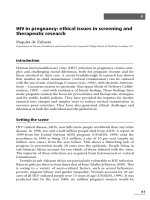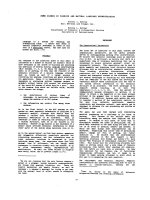Contemporary issues in marketing and consumer behaviour
Bạn đang xem bản rút gọn của tài liệu. Xem và tải ngay bản đầy đủ của tài liệu tại đây (1.22 MB, 232 trang )
Contemporary Issues
in Marketing and
Consumer Behaviour
This page intentionally left blank
Contemporary Issues
in Marketing and
Consumer Behaviour
Elizabeth Parsons
Senior Lecturer in Marketing, Keele University,
Keele University, Keele, Staffordshire, UK
Pauline Maclaran
Professor of Marketing and Consumer Research,
Royal Holloway, University of London, UK
AMSTERDAM • BOSTON • HEIDELBERG • LONDON • NEW YORK • OXFORD
PARIS • SAN DIEGO • SAN FRANCISCO • SINGAPORE • SYDNEY • TOKYO
Butterworth-Heinemann is an imprint of Elsevier
Butterworth-Heinemann is an imprint of Elsevier
Linacre House, Jordan Hill, Oxford OX2 8DP, UK
30 Corporate Drive, Suite 400, Burlington, MA 01803, USA
First edition 2009
Copyright © 2009, Elizabeth Parsons and Pauline Maclaran. Published by Elsevier Ltd. All
rights reserved
The right of Elizabeth Parsons and Pauline Maclaran to be identified as the authors of this
work has been asserted in accordance with the Copyright, Designs and Patents Act 1988
No part of this publication may be reproduced, stored in a retrieval system or transmitted
in any form or by any means electronic, mechanical, photocopying, recording or otherwise
without the prior written permission of the publisher
Permissions may be sought directly from Elsevier’s Science & Technology Rights
Department in Oxford, UK: Phone (ϩ44) (0) 1865 843830; fax (ϩ44) (0) 1865 853333;
email: Alternatively visit the Science and Technology Books
website at www.elsevierdirect.com/rights
Notice
No responsibility is assumed by the publisher for any injury and/or damage to persons or
property as a matter of products liability, negligence or otherwise, or from any use or operation
of any methods, products, instructions or ideas contained in the material herein.
British Library Cataloguing in Publication Data
A catalogue record for this book is available from the British Library
Library of Congress Cataloging-in-Publication Data
A catalog record for this book is available from the Library of Congress
ISBN: 978-0-7506-8739-3
For information on all Butterworth-Heinemann
publications visit our website at www.elsevierdirect.com
Typeset by Macmillan Publishing Solutions
(www.macmillansolutions.com)
Printed and bound in Great Britain
09 10 11 12 13 10 9 8 7 6 5 4 3 2 1
Working together to grow
libraries in developing countries
www.elsevier.com | www.bookaid.org | www.sabre.org
Contents
PREFACE
CONTRIBUTORS
Chapter 1
Introduction: Marketing in the Contemporary
Organization
Elizabeth Parsons and Pauline Maclaran
vii
ix
1
Chapter 2
A History of Marketing Thought
Mark Tadajewski
13
Chapter 3
Postmodern Marketing and Beyond
Pauline Maclaran
37
Chapter 4
Arts Marketing
Krzysztof Kubacki and Daragh O’Reilly
55
Chapter 5
Building Brand Cultures
Pauline Maclaran
73
Chapter 6
Consumer Collectives
Nia Hughes
89
Chapter 7
Gender and Consumer Behaviour
Lydia Martens
105
Chapter 8
Ethical Debates in Marketing
Elizabeth Parsons
121
Chapter 9
Sustainable Marketing and the Green Consumer
Caroline Miller
141
Chapter 10
Social Marketing and Consumer Citizenship
Effi Raftopoulou
161
Chapter 11
New Technologies of Marketing Research
Elizabeth Parsons
177
Chapter 12
The Global Consumer
Emma Surman
197
INDEX
213
v
This page intentionally left blank
Preface
The need for marketers to be flexible and adaptable to the changing world
around them has never been greater. As competition in markets grows
apace, and consumers make ever more demands on the companies from
which they choose to purchase, marketers must be increasingly sensitive
to a multitude of shifting socio-cultural nuances. This book is intended
to draw together a range of key topics that provide an overview into the
changing dynamic context within which marketing is taught and practised.
Overall, the topics are designed to keep students abreast of current thinking in marketing and consumer research. With an emphasis on socio-cultural perspectives, all of the chapters have been written by experts and often
challenge traditional views of marketing.
The principal market for this book is final year marketing undergraduates and students on post-experience and postgraduate marketing programmes. It is designed to be the recommended reading on courses that
explore contemporary issues in marketing and consumer research. As such
it functions as a complete off-the-shelf package, including class discussion
topics and exercises. On other modules, such as marketing theory, consumer
behaviour, ethics, macromarketing, marketing and public policy, social marketing and arts marketing, it is appropriate as supplementary reading. The
themes addressed in this book will also be of interest to students in media
and cultural studies, sociology, anthropology, CAM and consumer studies
programmes. So, whilst the main focus of the book is directed at the marketing community, it will also appeal to anyone who wants an accessible overview of the latest thinking and developments in marketing and consumer
research. Together the chapters are designed to provoke debate amongst students and encourage them to enquire further into the topics on their own.
vii
This page intentionally left blank
Contributors
Nia Hughes is Senior Teaching Fellow at Keele University, and prior to this
she was Principal Lecturer at Staffordshire University. She recently gained a
PhD from Lancaster University Management School, focusing upon aspects
of consumption in the context of collectors and collecting, and employing
an interpretivist approach. She is particularly interested in exploring the
familial, social and cultural factors that influence consumers in their everyday lives. Her work draws upon ideas from sociology, anthropology and
material culture studies, as well as consumer research.
Krzysztof Kubacki is Lecturer in Marketing at the School of Economic
and Management Studies, Keele University. He is a graduate of the School
of Music in Legnica, Poland, and before joining academia was working as a
musician for the Helena Modrzejewska Theatre in Legnica and the Opera
Theatre in Wrocław, Poland. Although his main research interests lie in the
relationship between marketing and music, he carries out research projects
on a variety of marketing issues in Poland and Central Europe. He has published extensively across a number of marketing areas, including music,
culture, the hospitality industry and knowledge management.
Pauline Maclaran is Professor of Marketing and Consumer Research at
Royal Holloway, University of London. Her research interests focus on cultural aspects of contemporary consumption, and she adopts a critical perspective to analyse the ideological assumptions that underpin many marketing
activities. In particular, her work has explored socio-spatial aspects of consumption, including the utopian dimensions of fantasy retail environments.
She has published in internationally recognized journals such as the Journal
of Consumer Research, Psychology and Marketing, Journal of Advertising,
and Consumption, Markets & Culture. She has co-edited several books
including Marketing and Feminism: Current Issues and Research and Critical
Marketing: Defining the Field, and is a co-author of Two Continents, One
Culture: The Scotch-Irish in Southern Appalachia. She is also Co-Editor in
Chief of Marketing Theory, a journal that promotes alternative and critical
perspectives in marketing and consumer behaviour.
Lydia Martens is Senior Lecturer in Sociology and Director of Postgraduate Training (Social Sciences) at Keele University. Her research interests centre around the intersections between consumption and domestic
life. She is working on a research agenda that includes gender and consumption, mundane domestic life, practices and products, and children, families
and consumption. Together with Pauline Maclaran, she is currently leading
ix
x Contributors
an Economic and Social Research Council seminar series on Motherhoods,
Markets and Culture. She is author of Exclusion and Inclusion: The Gender
Composition of British and Dutch Work Forces (1997), co-author (with
Warde) of Eating Out: Social Differentiation, Consumption and Pleasure
(2000) and co-editor (with Casey) of Gender and Consumption: Domestic
Cultures and the Commercialisation of Everyday Life (2007). She has also
published in various journals, including Journal of Consumer Culture,
Consumption, Markets and Culture, Home Cultures, Sociology and British
Journal of Sociology of Education.
Caroline Miller is Lecturer in Marketing at Keele University. She has
prior experience as a researcher at Manchester Metropolitan University.
She has also practised in the private sector where she spent fourteen years
working in the steel industry and has experience of running a family owned
small/medium sized business. She gained a PhD in Philosophy studying
women and entrepreneurship at Keele University and also has a Masters in
Research and a degree in Business Studies and English. Her research interests have a wide focus and include business start-up, gender, social exclusion (difference), sustainable practices in marketing and critical marketing.
Her publications are international and interdisciplinary; examples appear in
International Journal of Business and Economics and International Journal
for Management Theory and Practice.
Daragh O’Reilly is Lecturer in Marketing at the University of Sheffield
Management School. Before joining the academic sector, Daragh spent several years working in a range of international sales and marketing roles. His
recent research has focused on critical and cross-disciplinary work on the
relationship between marketing, consumption and culture. His particular
interests are arts marketing, and popular music branding. He was Chair of
the Academy of Marketing’s Arts & Heritage Marketing SIG from 2004 to
2007, and Principal Organizer of the ESRC seminar series on ‘Rethinking
Arts Marketing’ (2005–2007). He is also a member of a current AHRC grantaided Research Workshops project led by Elizabeth Carnegie to work with
Audiences Yorkshire on qualitative research into the arts consumption experience and its impact. He holds an MA in Modern Languages and Literature
(Dublin), an MBA (Bradford) and a PhD in the Marketing and Consumption
of Popular Music (Hallam). He is a Member of the Chartered Institute of
Marketing, and a holder of its Diploma.
Elizabeth Parsons is Senior Lecturer in Marketing at Keele University.
She has prior experience as Lecturer in Marketing at the University of
Stirling and gained a PhD in Human Geography from Bristol University.
Her research interests bring critical and ethnographic perspectives to two
key areas: the cultures of consumption, in particular the marketing and
consumption of the non-new, and the construction of gender and identity
in organizational life. Her publications are strongly inter-disciplinary, spanning journals in marketing, retailing, consumer research, geography and
Contributors
voluntary sector studies. She has recently co-edited the Sage three volume
major work on Nonprofit Marketing.
Effi Raftopoulou is currently Lecturer in Marketing at Keele University
and gained her PhD in Marketing at the University of Manchester. Her
research interests relate to two principal subject areas: the field of marketing communications (in particular, advertising), and the field of discourse
analysis. In particular she is concerned with the broader functions and role
of marketing communications from an ideological perspective. In addition
to this, she is interested in multi-semiotic analysis within discourse analysis
and its potential contribution to the study of adverts. One of the areas that
she has looked at relates to social/government advertising.
Emma Surman is a Lecturer in the School of Economic and Management
Studies at Keele University. After completing her PhD at Keele in 2004, Emma
was a Research Fellow at the University of Exeter and subsequently a Lecturer
at the University of Warwick before returning to Keele in August 2007. Prior
to her career in academia, she held marketing posts in a variety of organizations that encompassed the private, public and charity sectors. Her research
interests include: telework, emotion in the workplace, the production and consumption of organizational space, and gender, identity and power relations.
Mark Tadajewski is Lecturer in Critical Marketing at the School of
Management, University of Leicester. His research interests are wide-ranging
and include the history of marketing theory and thought, the philosophy
of science as it relates to marketing, critical theory and consumer research,
amongst others. He has co-edited several books, including Critical Marketing:
Issues in Marketing and Sage three volume major works on: The History of
Marketing Thought; Marketing Theory; Nonprofit Marketing; and Critical
Marketing Studies.
xi
This page intentionally left blank
CHAPTER 1
Introduction: Marketing in the
Contemporary Organization
Elizabeth Parsons and Pauline Maclaran
This book aims to provide an overview of the latest developments in
scholarship and practice in marketing and, importantly, make clear links
between the two. We have selected key topics that are currently impacting on the way marketing is researched and practised, and we use these to
explore newly emergent marketing ideas and applications. By locating these
topics in their wider global, social and economic contexts, we also raise a
series of theoretical concerns surrounding the interrelationships between
marketing, society and culture. We do this against the backdrop of marketing’s relevance in the contemporary organization. During a discussion of
current business opportunities with CEOs from five major UK companies
Brown noticed that ‘The term “marketing” was mentioned only a couple of
times in an hour of intense exchange. Yet customers, clients and competitiveness were on the executives’ minds throughout the discussion’ (2005,
p. 3). Marketing’s perceived lack of relevance is worrying. Many commentators have blamed this decline on an inadequate conception by both academics and practitioners of what marketing actually is. Thus, before we go
on to give an outline of our topic selections, we review some of the current
debates about the nature of the marketing role in contemporary organizations. This review provides a background context for the specific topics that
follow. First, however, we highlight some of the problems with the definition of marketing.
PROBLEMS WITH THE DEFINITION OF MARKETING?
Marketing as a phenomenon has changed significantly over the last 20
years. New fields of study have emerged such as relationship marketing,
Contemporary Issues in Marketing and Consumer Behaviour
Copyright © 2009, Elizabeth Parsons and Pauline Maclaran. Published by Elsevier Ltd
1
2 Contemporary Issues in Marketing and Consumer Behaviour
services marketing and the network perspective on business-to-business
marketing. Alongside this, attempts have been made to redefine both the
terminology and the terrain of marketing. Recently, several scholars have
aired their concerns about the direction in which marketing conceptualizations are moving (i.e. Wilkie, 2005; Grönroos, 2006). In this respect, the
following AMA (American Marketing Association) remodelled 2004 definition of marketing has been subject to particular scrutiny:
Marketing is an organizational function and a set of processes
for creating, communicating, and delivering value to customers
and for managing customer relationships in ways that benefit the
organization and its stakeholders.
A series of issues have been raised with this definition, pertaining to its
conception of the role of marketing within the organization, the role of consumers within the marketing relation and the wider societal role of marketing. Grönroos (2006) argues that the definition views marketing as one
function amongst others, and that such a conception of marketing is illequipped to deal with new forms of relationships with customers.
The traditional marketing definitions are based on a view that
marketing is one function alongside other functions and, therefore,
these are perceived as non-marketing. This view has become a
straight jacket for marketing research, where at least mainstream
marketing research has not been able to cope with the changes
that have taken place in the customer interfaces. The content of
customer interfaces has grown far beyond what a one function
marketing approach can handle. (Grönroos, 2006, p. 410)
A particular problem with the AMA definition, however, is the way
in which it characterizes the role of consumers in the marketing relation. Consumers are defined as having value delivered to them. Wilkie
sees this as a social problem as ‘In the aggregate, all marketers simply propose too much consumption for each consumer ’ (2005, p. 8). He observes
that, in this definition, the marketing system is structured as if finances
were no object for the consumer. The delivery of value to customers also
ignores their role in actively producing value (see Vargo and Lusch, 2004).
For example, consumer researchers have long recognized that value emerges
both in interactions between the consumer and supplier, and also through
a series of subsequent consumption practices and rituals where goods
are appropriated by consumers in their everyday contexts (see in particular the Consumer Culture Theory approach to understanding consumer
value, Arnould and Thompson, 2005). These consumption processes
may include an individual, or group characteristic (as in the case of consumer collectives discussed in Chapter 6). Taking the concept of value
co-creation one step further, Peñaloza and Venkatesh (2006) argue for the
Introduction: Marketing in the Contemporary Organization
importance of examining markets as social constructions. This has significant
implications for our understandings of value in markets: ‘our view emphasizes
value as constituted by marketers and consumers in their activities and discourses via an enacted process, a social construction that takes place prior to,
during and after the actual exchange and use(s) take place’ (2006, p. 303).
The dangers in adopting the AMA 2004 definition are that it only captures
the role of the marketing manager, and ignores the wider role of marketing
within society. Wilkie (2005, p. 1) argues for a ‘larger sense of marketing and
scholarship’ which takes into account the role of both government and other
organizational operations, particularly those which may be well beyond the
marketing manager’s control. Schultz (2007) similarly argues for a definition
of marketing that embraces a macro-marketing perspective where marketers
engage with the ‘big issues’ in society (see Chapter 12). This would involve an
opening out of marketing, and necessitates ‘greater understanding of historical and cultural forces, coupled with far-reaching systemic analysis’ (2007,
p. 299). Given the debate generated by the earlier 2004 definition of marketing, the AMA produced a second updated version in 2007, as below:
Marketing is the activity, conducted by organizations and
individuals, that operates through a set of institutions and processes
for creating, communicating, delivering and exchanging market
offerings that have value for customers, clients, marketers and
society at large.
This definition has yet to be fully applied and debated (although see
Sheth and Uslay, 2007), but it certainly seems to represent a step in the
right direction.
WHAT IS HAPPENING TO MARKETING’S ROLE IN THE
ORGANIZATION?
A series of scholars have charted the decline of marketing within the organization, observing that it has deteriorated in both influence and prominence
(McGovern et al., 2004; Welch, 2004; Brown, 2005; Cassidy, 2005; Webster
et al., 2005). Several elements of this decline have been observed including:
the loss of credibility of marketers and marketing at board level; and the
downwards devolvement of marketing responsibility in the organization.
In a survey of 30 large US companies more than 30 per cent indicated
that they spend less than 10 per cent of their time discussing marketing or
customer related issues at board level (McGovern et al., 2004). It is undeniable that marketing has been in decline within organizations for some time.
Following the closure of corporate marketing departments, companies have
plugged the gap by creating the position of chief marketing officer (CMO).
This has been viewed as a positive move by commentators. According to
a recent study by Booz Allen Hamilton (Hyde et al., 2004), 47 per cent of
3
4 Contemporary Issues in Marketing and Consumer Behaviour
fortune 1000 companies have a designated CMO. However, while marketing
is represented once more at board level, concerns have been raised about the
high turnover of these positions (Welch, 2004). Kerin (2005, p. 12) observes
that this is because ‘the position is often ill-defined, there is little formal
authority, corporate expectations are frequently unrealistic, and credibility
and legitimacy with other company “chieftains” is absent’. Cassidy’s (2005)
survey of more than 30 European CEOs and CMOs likewise found a ‘credibility gap’ for marketers in their organizations. She puts this down to the creative approach taken by successful marketers, which is at odds with the more
structured and disciplined approach required in other parts of the organization. This often makes for a significant amount of tension between CMOs
and other board members.
The problem may be one of a skills gap, according to McGovern et al.
(2004, p. 74) who highlight that the marketing field is ‘chockablock with
creative thinkers, yet it’s short on people who hew toward an analytic, leftbrain approach to the discipline’. This analytical skills gap is becoming
increasingly problematic as developments in information technology are at
the forefront of understanding consumer behaviour (see for example the data
mining techniques discussed in Chapter 11). In addition, the difficulties in
measuring marketing outcomes mean that marketers struggle to demonstrate returns on organizational investments in marketing programmes. As
McGovern et al. (2004, p. 75) observe, ‘Boards need a thorough understanding of how their companies are meeting customers’ needs and how their
marketing strategies support those efforts. No company we know of provides
its board with a scorecard that allows this.’ The combination of tensions
between individual skill valuations, and an often hostile organizational context, makes the CMO position a particularly difficult one to perform well
in. As Webster observes, ‘only rarely has this position been filled by a person
with the necessary strategic and analytical skills, the true support of a committed CEO, and a clear mandate to build marketing competence and strategic thinking throughout the organization’ (2005, p. 5).
In addition to problems at board level, many key marketing functions
have been dispersed throughout the organization. According to Webster et al.
(2005), many activities that might ordinarily be the preserve of the marketing department have been redistributed and embedded in functions such as
human resource management, sales and product engineering. ‘Today, marketing in many large companies is less of a department and more a diaspora
of skills and capabilities spread across and even outside the organization’
(2005, p. 36). Sheth and Sisodia further highlight how ‘many strategically
important aspects of marketing … are being taken away by other functions in the organization’ (2005, p. 11). This means that there is often little
direct responsibility for, and control over, marketing activity in the organization. The seriousness of the situation becomes clear when we consider the
issue of brand equity which is a key indicator of a company’s health. The
decentralization of responsibility for brand equity in many companies is
Introduction: Marketing in the Contemporary Organization
a worrying trend. Brands can be hugely unpredictable, often rising to prominence, or tumbling from pole position, almost overnight, so it is vital to
have at least some centralized control over them. For example, in the brand
consultancy Interbrand’s (2008) Best Global Brands rankings, the internet search engine company ‘Google’ was ranked 20th in 2007, by 2008 the
brand had risen to 10th in the rankings, achieving a 43 per cent increase
in brand value in just one year. In the same year, Apple computer hardware
saw a 24 per cent increase in brand value, Amazon internet service a 19 per
cent increase and ZARA apparel a 15 per cent increase. Equally, brands can
crash overnight, in the same period the brand value of Merrill Lynch financial services dropped 21 per cent, Gap apparel dropped 20 per cent and Ford
automotive dropped 12 per cent. These examples highlight just how volatile
markets can be, and therefore, how important it is to keep a close eye on the
brand’s performance.
WHAT DO CONSUMERS THINK OF MARKETING?
Given that serving consumers is marketing’s central purpose, their sentiments towards marketing activity deserve attention. In a survey by the market research company Yankelovich (cited in Sheth and Sisodia, 2005) 60 per
cent of consumers reported that their opinions of advertising and marketing activity had worsened in recent years. However, a long run survey of US
consumers’ sentiment towards marketing, conducted annually over the past
two decades, suggests that, while consumers generally have a negative opinion of marketing, these sentiments have slightly improved over the period
(Gaski and Etzel, 2005). Gaski and Etzel (2005) also observe that we are only
just beginning to understand the breadth of phenomena that influence these
sentiments. Perhaps not surprisingly, they find that of the four marketing
functions, product quality carries most importance in influencing consumer
sentiments, followed in order of decreasing importance by price, retail service
and advertising. In addition, while this study finds that consumers do have
a negative view of marketing, in the aggregate and over a long period of time
this negative view is only slight and ‘not nearly as unfavorable as popular stereotype may have represented’ (Gaski, 2008, p. 212).
However, Sheth and Sisodia (2006) report a growing cynicism amongst
consumers with few consumers viewing their interactions with companies
as fulfilling relationships. From their online survey they found that over
60 per cent of consumers had a negative view of marketing. While positive
connotations included creativity, fun, humorous advertising and attractive
people, on the negative side frequently used words included: lies, deception,
deceitful, annoying, manipulating, gimmicks, exaggeration, invasive, intrusive and brainwashing (see Chapter 8 for a discussion of marketing ethics).
In terms of marketing practices telemarketing, online pop-up advertisements and junk mail were viewed most negatively (2006, p. 30).
5
6 Contemporary Issues in Marketing and Consumer Behaviour
HOW SHOULD MARKETING BE DONE DIFFERENTLY?
Given the decline of marketing in organizations, and the generally poor view
consumers have of marketing activity, how should marketing be done differently? This is not an easy question to answer, but two key suggestions are
discussed here: the linking of marketing productivity with strategy; and the
development of a collaborative approach to marketing. The latter approach
would involve productive practitioner–scholar relations and require organizations to work more closely ‘with’ the consumer.
As we discussed in previous sections, marketers are being marginalized
in the organization. Whenever they do have a role to play, their hands are
often tied by a lack of wider organizational commitment to a market-focused
perspective. Marketing is often viewed as a variable cost on the balance
sheet, rather than a committed cost. Thus, in times of financial hardship,
marketing budgets are often the first to be cut. To avoid this situation, from
marketing programmes need to be measured more accurately and applied
to strategic decision making. For example, a strong brand can result in a
whole host of cost savings for the organization, such as the ability to negotiate lower distribution costs. Savings of this nature need to be accounted for
as positive outcomes of marketing programmes. This ability to account for
marketing expenditure will help in persuading board members of the true
value of marketing activity and, hopefully, precipitate a move towards a commitment to marketing within the organization.
There remains a significant scholarship–practitioner gap in marketing.
One of the solutions Brown (2005) offers is for scholars to broaden their conception of practitioner audience, to embrace not only marketers, but also strategic management, operations, supply chain, human resources and finance.
The ‘thought leadership in relation to customer focus and competing through
service’ offered by marketers is ‘too good to be confined to marketing practitioners’, he argues (2005, p. 4). Certainly the time is ripe to forge fruitful
partnerships between academics and business leaders. Business leaders have
little time or encouragement to reflect on the role and nature of marketing in
their organizations. They can offer insights, however, into the ways in which
marketing is playing out in the business context. This will include a focus on
the challenges they face, as well as new ideas surrounding what might and
what might not work in their company contexts. The potential for scholars
to contribute to marketing thought and practice has never been greater. The
need for organizations to develop measurable return on marketing spending,
the development of new forms of customer interfaces brought about by new
technologies, and the rise of the brand as a central guiding principle in organizations, all cry out for sustained and in-depth reflective analysis that practitioners simply do not have the time or, indeed, the resources to undertake.
A final comment regarding the doing of marketing ‘differently ’ relates
to companies working with the consumer. This can be achieved by creating
Introduction: Marketing in the Contemporary Organization
systems which result in mutual value through actively supporting, rather
than directing, consumer creation of value. The internet technology available to marketers, while being a potential threat in its empowerment of
the consumer through information and connectivity to other consumers,
must be seen as an opportunity in enabling a more equal and co-operative relationship between companies, marketers and their consumers. The
increasing popularity of the internet is resulting in a form of ‘do it yourself ’
marketing where consumers cut out the marketing middle man in accessing information on pricing and product features and quality. As Sheth and
Sisodia observe, consumers can ‘self-inform, self-evaluate, self-segment, selfsupport, self-organize, self-advertise, self-police and self program’ (2005, p.
11). The online trading community eBay is perhaps one of the most obvious examples of these elements of consumer marketing in action. Another
example is the whole range of online consumer communities where experiences of using products, and opinions about brands are shared (see Chapters
6 and 11). In fact, Sheth and Uslay point out that value co-creation can
extend to a whole spectrum of activities:
coconception (military and defense contracts), codesign (Boeing and
United Airlines), coproduction (Ikea), copromotion (word of mouth),
copricing (eBay, negotiated pricing), codistribution (magazines),
coconsumption (utility), comaintenance (patient–doctor), codisposal
(self-serve), and even co-outsourcing (captive business process
outsourcing). (2007, p. 305)
The value co-creation view of marketing has significant repercussions
for the means marketers should use to try and understand consumers and
markets. Chapter 11 documents a range of new techniques in this respect
(i.e. videography, netnography, blogs and virtual life worlds) which not only
involve the consumer in a dialogical relationship with marketers but benefit
from being used in conjunction with more traditional techniques to facilitate the triangulation suggested by Peñaloza and Venkatesh ‘Over time then,
and with greater triangulation across interpretavist and positivist paradigms
in the context of market development, value may be seen to be constituted
in exchange and use, simultaneously and sequentially ’ (2006, p. 303).
There is still a feeling that marketers can do more to work with the
consumer. As Lafley, chief executive of Proctor and Gamble Company commented recently, ‘we’re on a learning journey together ’ with the consumer
‘choosing when to tune in and when to tune out. Consumers are beginning in a very real sense to own our brands and participate in their creation.
We need to learn to begin to let go’ (cited in Elliott, 2006). When talking
about the fact that some Mini owners dress their cars up in costumes for
Halloween and some have mounted shark fins on the roof of their Minis –
McDowell, managing director at Mini USA, commented ‘It’s a great thing
every day to wake up and see what consumers have done to the brand, even
7
8 Contemporary Issues in Marketing and Consumer Behaviour
though it’s not a culture we necessarily would have come up with on our
own’ (cited in Elliott, 2006). Putting the customer in charge is often very
uncomfortable for organizations with a history of ‘consumer management’.
Flanagan, executive vice president and chief marketing officer at MasterCard
Worldwide, whose recent ‘Priceless’ campaign was adopted and adapted by
consumers, observes ‘when you’re tapping into that consumer desire to have
a piece of it, you have to take the good with the bad’ (cited in Elliott, 2006).
So, there are many uncertainties for the marketing role, both inside
and outside the organization. The one certainty is that marketers need to
become more flexible and adaptable than ever before, ready to respond to
a volatile and fast-changing marketplace that increasingly demands they
act responsibly and play an active role in good citizenship. Our selection of
topics is intended to give students a greater understanding of the changing
dynamics in which marketing is researched and practised.
OUTLINE OF THE BOOK
Our first two topic areas in this book consider aspects of the theoretical and
practical context in which we undertake marketing activities. In an overview of ‘A History of Marketing Thought’ (Chapter 2), Mark Tadajewski
provides an important foundational, historical background against which
to understand the development of the contemporary issues that follow, enabling us to locate them in relation to the overall development of
marketing thought. He tracks marketing’s emergence and growth as a discipline, together with the influences that have impacted this evolution.
Importantly, he reveals the impact of particular sets of power relations during key periods of development in marketing thinking. To this end, he looks
at the close ties between the genealogy of marketing thought and practice,
and the changes in the US political and economic climate.
Likewise, the next chapter on ‘Postmodern Marketing and Beyond’
(Chapter 3) provides a base from which to appreciate our other topics. In
it we explore the defining characteristics of the postmodern turn, and the
many ways postmodernism has represented a critique of, and challenge to,
the underpinnings of conventional marketing wisdom. We also chart recent
developments of the postmodern concept within marketing and explore its
links with cultural branding and interpretive consumer research. Despite
its own critique of traditional assumptions, postmodernism is itself open
to critique, and we consider the various limitations of using a postmodern
lens. Significantly, certain current trends indicate that we may now be moving beyond postmodernism and we consider the potential impact of this for
marketers.
Following these two contextualizing chapters, we shift our focus to
consider more specific socio-cultural contexts in which marketing practice takes place. Our postmodern analysis reveals how art and life are now
Introduction: Marketing in the Contemporary Organization
inextricably intertwined and the next chapter pursues this theme from a
marketing management perspective. ‘Arts Marketing’ (Chapter 4) is a relatively new subdiscipline of marketing. In this chapter, Krzysztof Kubacki
and Daragh O’Reilly locate arts marketing within the larger framework of
cultural production and consumption, before exploring the complexities
of the relationship between art and the market. They highlight a range of
special considerations for arts marketers, considerations that mean conventional product marketing approaches do not work in this context. In so
doing, their analysis reveals two main approaches to arts marketing that
offer very different conceptualizations of it. In the preceding chapter, we see
how, from a postmodern perspective, brands are infused with art, whereas
this chapter shows how art is infused with brands.
Brands are everywhere in contemporary society. In ‘Building Brand
Cultures’ (Chapter 5) we look at how meaning systems are established
around brands, and how these can take on a life of their own as the brand
intersects with other cultural phenomena such as, for example, the art world
just discussed. Adopting an ‘inside out’ approach, we explore important synergies between organizational and brand cultures, illustrating the important
role of employees in building brand culture. Shifting our focus outside the
organization, we consider how brand cultures are also co-created with consumers and other external stakeholders. The evolution of brand culture is
concerned with story telling, but not, as we might expect, just on the part
of marketers. Employees, customers and the media are continually relating experiences about brands and, as they do so, certain meanings evolve,
meanings that may not have been intended by marketers. Highly successful brands achieve iconic status through responding insightfully to the wider
cultural environment and being aware of the stories circulating about them.
Other brands are less watchful, however, and become tainted through negative perceptions that arise and over which marketers sometimes have little
control. Whether we like them or not, brands play an increasingly significant role in contemporary lifestyles. They are also increasingly coming
under attack from the anti-branding movement, which heavily critiques the
role of brands and the impact of brand culture on our lives.
Many critiques can be levelled at the marketing system, not least that it
contributes to a fragmentation of society through the increasing proliferation
of smaller and smaller market segments. Conversely however, in Chapter 6,
‘Consumer Collectives’, Nia Hughes illustrates the communal bonds that
can be forged through marketing phenomena. Contemporary consumer culture is often implicated in the breaking down of traditional bonds between
people such as class, caste, family or village. Yet, as this chapter shows,
consumers find new ways to establish collective identities through selecting specific products, services and activities that define themselves and create a social identity that they communicate to others. A range of marketing
collectives have been identified: lifestyle groupings, subcultures, subcultures
9
10 Contemporary Issues in Marketing and Consumer Behaviour
of consumption, brand communities, consumer micro-cultures and tribes.
All of these concepts share the same underlying principle, that choices of
goods and services make a statement about who we are and, importantly,
with whom we wish to identify (or with whom we do not). In reflecting a
group identity, consumption activities can be highly symbolic and often the
meanings that consumers create collectively can be beyond the control of
marketers. This chapter explores the similarities and differences between
these different concepts of consumer collectives.
In Chapter 7, Lydia Martens uses a sociological perspective to understand
the topic of ‘Gender and Consumer Behaviour ’, a topic that has been largely
overlooked in marketing. Once again, as in Chapter 2, we are reminded of
the importance of understanding historical perspectives to better appreciate
the subtleties of contemporary issues. Lydia highlights the significance of
feminist thought in shaping social and cultural agendas and applies this to
our understanding of how gender impacts consumer behaviour. She explores
various theories of consumption and gender that try to explain how gender
shapes particular patterns of consumer behaviour and meanings, and vice
versa, how consumption patterns and meanings shape gender culture.
The next three topic choices move us away from specific socio-cultural
contexts to focus more on the ethical and political context of marketing theory and practice. In ‘Ethical Debates in Marketing’ (Chapter 8), we review
debates surrounding the moral principles that guide the conduct of marketers. Here we include discussion of marketing as a profession and also as
a wider societal force. The growing diversity of the socio-cultural environment in which marketers operate means that they will need to be capable
of assessing the ethical implications of their actions across an increasingly
broad range of contexts. Marketers have to take into account three key
viewpoints – the company, the industry and society – and it is when these
groups have conflicting needs and wants that ethical problems arise (e.g. the
tobacco industry).
In ‘Sustainable Marketing and the Green Consumer ’ (Chapter 9), Caroline
Miller highlights the paradoxical nature of the term sustainable marketing. She discusses how marketing activities can be heavily critiqued for their
encouragement of wastage and for their contribution to the destruction of the
environment. One of the major challenges for marketing lies in how it can
help to encourage organizations and industry sectors along a more environmentally sustainable path. This chapter explores the birth and evolution of
sustainable marketing and looks at the significant steps and setbacks in its
development. It also discusses key aspects of green marketing and the green
consumer, and looks at how the balancing of consumption and conservation
is a challenge, not only for individuals but also for organizations. Emphasizing
the need for a more holistic view to be taken by marketers, leading scholars in
the field of sustainable marketing are now calling for a significant rethinking
of the nature/culture divide.
Introduction: Marketing in the Contemporary Organization
Faced with mounting pressure from consumers and companies, marketers are becoming increasingly aware of their citizenship role in society. This
emerging topic is the focus of the next chapter by Effi Raftopoulou. ‘Social
Marketing and Consumer Citizenship’ (Chapter 10) explores the emergence
of social marketing as a subdiscipline which can be associated with broader
shifts in the boundaries of marketing in the late 1960s. Social marketing as a
concept has gained ascendancy in a range of professional circles and is used
in a range of spheres including: societal (i.e. re-educating against racism),
political (i.e. promoting the EU), environmental (i.e. saving energy, re-cycling)
and health (i.e. safer sex, healthy eating, smoking cessation). However social
marketing is not confined to marketing communications and can make a
unique contribution to both behaviour change and critical marketing.
Many fast-changing technological innovations have recently impacted on
the marketing role and our two concluding chapters explore this new technological environment. In ‘New Technologies of Marketing Research’ (Chapter 11)
we explore recent developments in marketing research and relate them to
broader technological and cultural changes in society. Technological developments have had a huge impact on the practices of marketing research, offering
marketers vast amounts of data on the consumer. Indeed some commentators have observed the birth of ‘data driven’ marketing. However an important second shift has seen moves towards more interpretive understandings
of consumers. This shift might be located more broadly in the postmodern
turn within marketing, a turn which has resulted in a more eclectic approach
to marketing research, making new uses of the available technologies, for
example netnographies, videographies blogs and virtual life worlds. These
new techniques can be seen as emancipatory when they involve the consumer
more fully in a dialogical relationship with marketers. Trends also reflect a
willingness to look outside traditional marketing to other disciplines for inspiration. Evidence of this can be seen in the proliferation of marketing research
agencies staffed by anthropologists, sociologists and cultural theorists.
Technological advances have also driven an increasing globalization of
products and services. Through technology, we are increasingly linked to
people and activities throughout the rest of the world. Our final chapter by
Emma Surman, ‘The Global Consumer ’ (Chapter 12), explores the intertwining of the technological, cultural, political and economic environments.
It provides an overview of the process of globalization and discusses many
of the resulting debates. Emma encourages us to question the power and
influence of multinational companies and to think about how local cultures
are affected by global production and consumption.
Written as an introductory overview, each of the above chapters includes
a range of current examples of research and practice and concludes with a
more detailed case study. There are recommended discussion and group
exercises which, together with key readings and internet resources, are
designed to stimulate debate and further exploration. Enjoy!
11
12 Contemporary Issues in Marketing and Consumer Behaviour
REFERENCES
Arnould, E.J. and Thompson, C.J. (2005), ‘Consumer culture theory (CCT): Twenty
years of research’, Journal of Consumer Research, 31 (4), 868–882.
Brown, S.W. (2005), ‘When executives speak, we should listen and act differently ’,
Journal of Marketing, 69 (October), 1–4.
Cassidy, F. (2005), ‘A credibility gap for marketers’, McKinsey Quarterly, 2, 9–10.
Elliott, S. (2006), ‘Letting consumers control marketing: Priceless’, The New York
Times, October 9.
Gaski, J.F. (2008), ‘The index of consumer sentiment toward marketing: Validation,
updated results, and demographic analysis’, Journal of Consumer Policy, 31,
195–216.
Gaski, J.F. and Etzel, M.J. (2005), ‘National aggregate consumer sentiment toward
marketing: A thirty-year retrospective and analysis’, Journal of Consumer
Research, 31 (March), 859–867.
Grönroos, C. (2006), ‘On defining marketing: Finding a new roadmap for marketing’, Marketing Theory, 6, 395–417.
Hyde, P., Landry, E. and Tipping, A. (2004), ‘Making the perfect marketer ’, Strategy
and Business, (winter), 37–43.
Interbrand (2008), Best Global Brands 2008. />best_global_brands
Kerin, R.A. (2005), ‘Strategic marketing and the CMO ’, Journal of Marketing, 69
(October), 12–14.
McGovern, G.J., Court, D., Quelch, J.A. and Crawford, B. (2004), ‘Bringing customers into the boardroom’, Harvard Business Review, 82 (November), 70–80.
Peñaloza, L. and Venkatesh, A. (2006), ‘Further evolving the new dominant logic
of marketing: From services to the social construction of markets’, Marketing
Theory, 6 (3), 299–316.
Schultz, II., C.J. (2007), ‘Marketing as constructive engagement’, Journal of Public
Policy and Marketing, 26 (2), 293–301.
Sheth, J.N. and Sisodia, R.S. (2005), ‘Does marketing need reform?’, Journal of
Marketing, 69 (October), 10–12.
Sheth, J.N. and Sisodia, R.S. (eds) (2006), Does Marketing Need Reform: Fresh
Perspectives on the Future. New York: M.E. Sharpe.
Sheth, J.N. and Uslay, C. (2007), ‘Implications of the revised definition of marketing: from exchange to value creation’, Journal of Public Policy and Marketing, 26
(2), 302–307.
Vargo, S.L. and Lusch, R.F. (2004), ‘Evolving to a new dominant logic for marketing’, Journal of Marketing, 68 (January), 1–17.
Webster, Jr., F.E. (2005), ‘Back to the future: Integrating marketing as tactics, strategy and organizational culture’, Journal of Marketing (October), 4–6.
Webster, Jr., F.E. Malter, A.J. and Ganesan, S. (2005), ‘The decline and dispersion of
marketing competence’, MIT Sloan Management Review, 46 (4), 35–43.
Welch, G. (2004), CMO Tenure: Slowing the Revolving Door. New York: Spencer
Stuart.
Wilkie, W.L. (2005), ‘Needed: a larger sense of marketing and scholarship’, Journal
of Marketing, 69 (October), 8–10.









